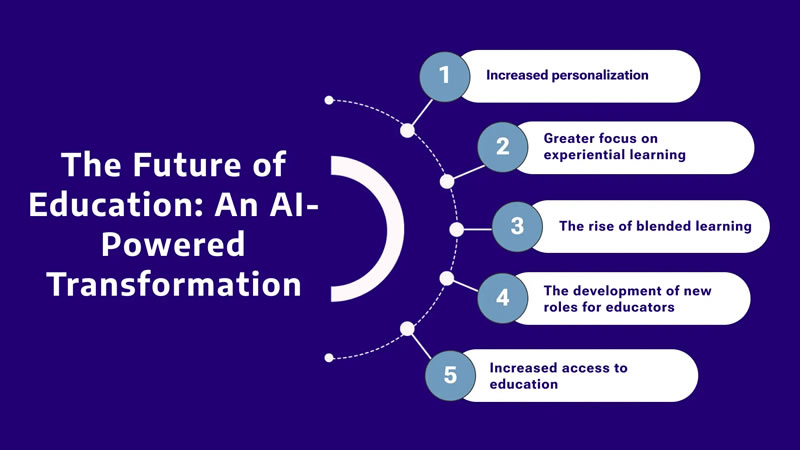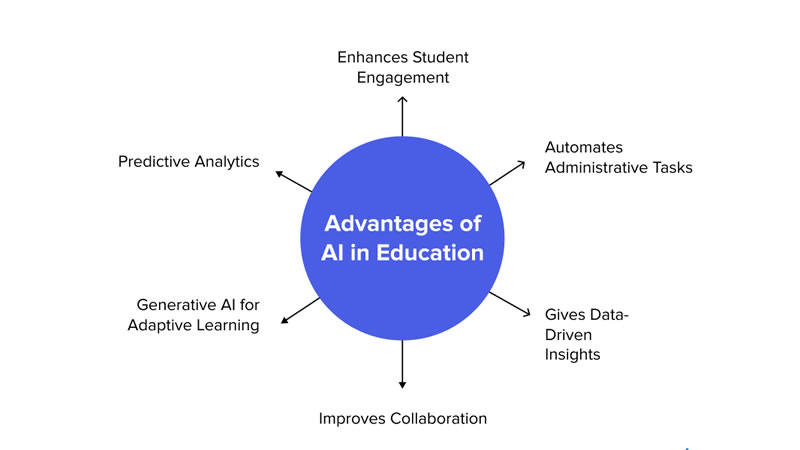Artificial Insights (AI) is no longer a fair cutting-edge concept. It is forming businesses over the globe, and instruction is no exception. From personalized learning stages to brilliantly mentoring frameworks, the utilize of artificial intelligence in education in instruction is changing how students learn and how instructors instruct. The role of artificial intelligence in education is growing quickly, bringing both opportunities and challenges.

This article investigates the key developments in AI-driven instruction, its benefits and limitations, and what the future might hold as schools, colleges, and online platforms proceed to embrace these technologies.
The Developing Part of Artificial Intelligence in Education
Education has continuously been molded by innovation. From chalkboards to e-learning stages, each step has re-imagined learning encounters. Nowadays, AI is at the center of this change. Not at all like prior apparatuses, AI doesn’t fair provide content; it adapts to learners, analyzes execution, and gives real-time support.
The part of counterfeit insights in instruction can be seen in three major areas:
1. Personalized Learning
Every understudy learns unexpectedly. AI-driven stages analyze learning styles, speed, and execution to make personalized lesson plans. Versatile learning frameworks like DreamBox, Carnegie Learning, and Squirrel AI alter trouble levels naturally, guaranteeing understudies are not one or the other overpowered nor underchallenged.
2. Automation of Authoritative Tasks
Teachers spend a critical amount of time reviewing assignments, overseeing participation, and dealing with printed material. AI instruments automate these errands, giving teachers more time to center on educating and mentoring students.
3. Smart Mentoring Systems
Intelligent coaching frameworks (ITS) act like virtual instructors. They can clarify concepts, reply to questions, and indeed distinguish when a understudy is battling. Not at all like inactive online lessons, these frameworks utilize real-time information to direct learners step by step.
Key Advancements in Counterfeit Insights in Education
AI in instruction is not fair approximately replacing ancient apparatuses with computerized forms. It’s almost reimagining how information is conveyed and surveyed. A few of the most impactful advancements include:
1. Versatile Learning Platforms
AI-powered, versatile frameworks tailor lessons to a person’s advanced needs. For instance, if an understudy battles with divisions, the framework gives additional work-outs and criticism some time recently moving on. This level of personalization was about outlandish in conventional classrooms.
2. AI-Powered Virtual Classrooms
Virtual learning is more than fair video calls. Stages improved with AI give real-time interpretation, speech-to-text highlights, and enthusiastic acknowledgment to keep students locked in. These developments bridge holes for worldwide students, learners with disabilities, and further communities of artificial intelligence in education.
3. Clever Substance Creation
AI can produce tests, flashcards, and hone tests naturally. This diminishes the workload for instructors and guarantees students have a persistent supply of think about fabric custom-made to their curriculum.
4. Learning Analytics and Prescient Insights
By analyzing understudy execution information, AI tools can foresee results such as dropout dangers or exam execution. Early discovery makes a difference; teachers give convenient interventions.
5. Gamified and Immersive Learning
AI-driven gamification includes an unused measurement for instruction. Virtual reality combined with AI can make immersive recreations, permitting students to investigate chronicled events, logical tests, or real-world problem-solving scenarios.
6. Brilliantly Dialect Learning Tools
Apps like Duolingo and ELSA Talk utilize AI to analyze elocution, language structure, and familiarity. They give moment adjustments and versatile workouts, making dialect learning more interactive.
7. Availability Solutions
AI plays a key part in making instruction comprehensive. From real-time translation for hearing-impaired students to AI-driven text-to-speech for outwardly impaired learners, innovation guarantees no one is left behind.

Advantages of Counterfeit Insights in Education
The focal points of counterfeit insights in education are wide-ranging and impactful.
- Personalization: Understudies get customized learning paths.
- Efficiency: Instructors’ spare time on reviewing and administration.
- 24/7 Accessibility: AI guides are continuously available, not at all like human teachers.
- Inclusivity: Learners with disabilities can access instruction more easily.
- Data-Driven Experiences: Schools and teachers can track advances and progress strategies.
These benefits are why schools and colleges around the world are quickly adopting AI technologies.
Disadvantages and Concerns
While the benefits are promising, it is similarly imperative to recognize the drawbacks of artificial intelligence in education in education.
- Lack of Human Touch: AI cannot supplant the passionate support and mentorship of teachers.
- Bias in Calculations: If preparing information is one-sided, AI frameworks may provide unjustifiable or wrong results.
- Cost of Execution: Progressed AI arrangements can be costly for schools in developing regions.
- Overreliance on Innovation: Over the top utilize of AI may decrease basic thinking and imagination among students.
- Privacy Issues: Information collection on understudy execution raises concerns approximately security and misuse.
Balancing the preferences and drawbacks of counterfeit insights in instruction is essential for sustainable adoption.
The Future of AI in Education
Looking ahead, the future of AI in instruction is filled with conceivable outcomes. A few likely patterns include:
Hyper-Personalized Learning Ventures where AI not as it were adjusts lessons but also prescribes career paths and learning resources.
Collaborative AI Apparatuses that interface students around the world to work on global projects.
AI-Powered Appraisal supplants conventional exams with nonstop, versatile evaluations.
Emotional AI can understand understudy temperaments and alter teaching approaches accordingly.
Integration with AR and VR for immersive and experiential learning.
These advancements seem to rethink classrooms, making them more energetic, intuitive, and successful than ever before.

Conclusion
Artificial insights in instruction are more than a trend; it is getting to be a foundation of present-day learning. The utilization of artificial intelligence in education is making a difference understudies learn at their possess pace, supporting instructors in their day-to-day assignments, and creating more comprehensive learning situations. At the same time, challenges such as fetched, security, and the requirement for human interaction must be addressed.
When actualized mindfully, AI can serve as a capable accomplice in instruction or maybe a substitute for instructors. The future of learning will likely be a mix of human skill and counterfeit insights, working together to enable students worldwide.
1. What is the part of artificial intelligence in education?
AI makes a difference by personalizing learning, automating authoritative assignments, giving shrewd coaching, and fostering openness for different learners.
2. What are the points of interest of artificial intelligence in education?
It offers personalized learning, productivity, inclusivity, data-driven bits of knowledge, and round-the-clock support.
3. What are the impediments to artificial intelligence in education?
Potential downsides include loss of human interaction, algorithmic inclination, high costs, information security issues, and overdependence on technology.
4. How is AI utilized in instruction today?
AI is utilized in versatile learning stages, intelligent coaching frameworks, content creation, accessibility tools, and predictive analytics.
5. What is the future of counterfeit insights in education?
The future incorporates hyper-personalized learning, enthusiastic AI, immersive AR/VR classrooms, and AI-powered appraisals.

